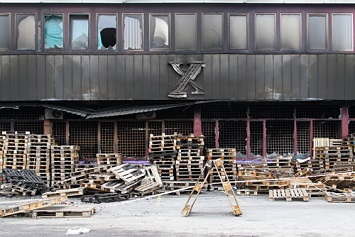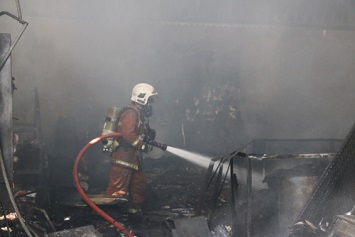Every facility needs to have an adequate fire prevention and preparedness strategy. This is especially true for facilities with warehouses on site, where facility managers need a unique strategy depending on the types of products or materials that are stored on site. These concerns were on attendees’ minds in the standing-room-only crowd for Tim Dietz’s and Ray Panko’s presentation on the first day of the American Society of Safety Professionals’ (ASSP) Safety 2019 Conference and Exposition, held in New Orleans, Louisiana.
During the session, Dietz and Panko of Chubb highlighted proven and effective fire prevention solutions designed for the unique hazards and challenges presented by warehouse facilities. The speakers recommended that facility managers and warehouse operators keep several factors in mind when evaluating their fire protection systems, including the classification of the commodities stored, the fire protection schemes used, and the common hazards these types of facilities face. Dietz and Panko stressed the importance of preplanning to mitigate the risks.
Commodity Classification
One variable in warehouse fire hazard assessments that often gets overlooked is how the commodity classification of the materials stored in the warehouse contributes to the risk of fire. Pursuant to the system developed by the National Fire Prevention Association (NFPA), potentially combustible materials are classified based on the fire risk that they pose. These classifications range from Class I for noncombustible products to Class IV for products containing Group A plastics in ordinary corrugated cartons or products with Group A plastic packaging with or without pallets. Plastics are classified as Group A, Group B, or Group C based on their heat of combustion and burning rate. Still other commodities are considered “special commodities” due to the unique fire hazards they present, such as ignitable liquids, rolled paper, aerosols, and hanging garments.
When warehouse facilities change the products they store or the packaging materials they use, the associated changes to the commodity classifications of these materials are often disregarded, causing the existing fire prevention or suppression systems to become inadequate for the hazards present. Dietz and Panko urged attendees to pay attention to these classifications, particularly in light of any facility design or process changes, to make sure that the storage solutions are suitable for the hazards present and that the fire protection systems in place are appropriate for the new warehouse practices.
Fire Protection Schemes
Dietz and Panko also suggested that attendees become familiar with the type of fire protection system used in their facilities and its possible limitations. Specifically, they described sprinkler systems, including Control Mode Density Area (CMDA) systems, which provide a prescribed amount of water over a specific floor area to control a fire but not to extinguish it; Control Mode Special Application (CMSA) systems, which provide specific pressure through a specific number of sprinklers; and Early Suppression Fast Response (ESFR) systems, which provide a large quantity of water over a small operating area, with the intent to extinguish the fire. Depending on the specific materials stored in warehouse owners’ and operators’ facilities, one system may be better suited than another. Similarly, depending on the system a warehouse has, some materials may be more hazardous to store than others.
The hydraulic calculations placard of a fire protection system typically explains what the system is designed to do, and owners and operators were urged to consider these specifications before making significant changes to the use of their warehouse facilities.
Common Warehouse Hazards
Attendees were also asked to consider hazards frequently found in the warehouse setting when evaluating their fire prevention and protection strategy and to take steps to mitigate their risk. These hazards included:
- Hot work near combustible materials when repairing storage racks damaged by forklifts;
- High-intensity discharge (HID) lamps, which can burst and spread hot elements if the wrong bulb is used in open fixtures;
- High-velocity, low-speed (HVLS) fans, which can displace enough air to push a heat and smoke plume away from the nearest sprinkler head, delaying the activation of a sprinkler system;
- The use of forklift battery chargers in storage racks, which can release gas that collects and ignites; and
- Poor housekeeping, which can allow incipient fires to spread rapidly.
So What Can You Do?
In the face of these heightened fire risks, what can facility managers and warehouse owners do to best protect their facilities? Preplan, according to Dietz and Panko.
Preplanning with the local fire department is critical to a facility’s fire prevention and preparedness strategy. Fire officials should visit the building at least annually to become familiar with the materials stored and the facility’s layout, lanes, and hazards. Routine drills may also be necessary. The department can evaluate the facility’s water supply to make sure it is adequate in terms of both pressure and quantity, and facility managers can provide officials with the safety data sheets (SDSs) for any hazardous materials stored. Furthermore, facility personnel should provide maps of the facility that are marked with the hazard locations and access routes. Helping fire officials understand a facility’s operations and processes is vital for protecting the officials and the facility alike.
Dietz and Panko also recommended that facility managers and warehouse owners plan for and consider any business continuity issues that could be triggered by a fire event and establish an electrical shutdown process for any equipment if needed.
Finally, warehouse owners and operators may want to reach out to their insurance carriers for additional fire protection design recommendations, especially with respect to property protection.


